Last winter I reviewed the fantastic Rurik: Dawn of Kiev, a game originally launched on Kickstarter in 2018 and shipped to backers in August 2019. I found a lot to love with the game, awarding it with a GeekDad Approved seal. Now PieceKeeper Games and designer Stanslav Kordonskiy are back on Kickstarter with their first expansion, Rurik: Stone & Blade. They sent me a prototype to take a look.
What is Rurik: Stone & Blade?
Rurik: Stone & Blade is a modular expansion to Rurik: Dawn of Kiev. A copy of the original game is required to play. It consists of core content and three individual modules. It is for 1-4 players, ages 13+, with an estimated playtime of 35 minutes per player. A pledge for just the expansion is $39, or if you’re new to the game, you can get a copy of Rurik: Dawn of Kiev along with Stone & Blade for $114. There’s also an all-in pledge that includes the base game, expansion, neoprene playmat, metal coins, and honey cubes for $159. Finally, there’s a limited pledge that’s the same as the all-in, except it will ship you out a copy of Rurik: Dawn of Kiev at the close of the Kickstarter, rather than along with the expansion when it ships. It’s currently seeking funding on Kickstarter.
New to Kickstarter? Check out our crowdfunding primer.

Rurik: Stone & Blade Components
The expansion adds the following components to the game:
- 2 Leader Miniatures and Cards
- 16 Structures
- 12 Trade Boon Tokens
- 6 Warfare Reward Tokens
- 12 Victory Point Tokens
- 15 Inheritance Cards
- 8 Deed Cards
- 4 Reference Cards
- 23 Solo Cards
- 2 Agenda Cards
- 7 Epic Structures
- 6 Epic Structure Cards
- 4 Dungeon Mats
- 4 Conversion Tokens
- 5 Scheme Cards
- 3 Rebel Faction Cards
- 1 Rebel Camp
- 4 Rebel Miniatures
- 4 Rebel Reward Tokens
I had been sent a prototype copy, so some of the components are not of the same quality as of what will be in the final product (which will be similar to the high quality of the Rurik base game.) Some notable differences:
- The Peasant Mutiny rebel faction card will have an illustration.
- The Dungeon Mats will be 2mm thick punchboard, similar to the household mats.
- All the structures will be wood, not the plastic used in the prototype.
How to Play Rurik: Stone & Blade
This is a modular expansion, meaning that there is “core” content, as well as three separate modules. The core content is meant to be added to all future games of Rurik: Dawn of Kiev, while you can add any or all of the modules as you desire to your games.
Note that the expansion will ship with a new set of cards for solo play, but those were not available in the prototype I received so I will not be discussing any changes to the solo mode.

Core Content
This is the bulk of the expansion. It’s suggested that you integrate the core content of the expansion into all future plays of Rurik: Dawn of Kiev, whether you add in any of the three modules or not. Here are the changes made to your standard setup (you can refer to my original review of Rurik for full setup and rules on how to play.)
Setup and Play
Give each player two coins to start instead of three. Add the four additional rebel miniatures into the supply, and shuffle all the Deed cards with the “core content” symbol (a crossed hammer and sword) in with the base game deed cards. Continue with normal setup until steps 16-17, which will be replaced by the following:
Deal three Inheritance cards to each player. Everyone selects two to keep, discarding the third.

Players take turns placing troop miniatures into regions of their choice until everyone has placed two troops. Then players place their leader miniature into a region that they occupy.
Players then take turns revealing their Inheritance cards and collect the corresponding starting bonuses. Troops and structures are always placed in the region listed on those cards, unless the player pays a coin to instead place it in any region. For example, if someone played the Rostov card, by paying one coin, they can place a stronghold in Rostov. Alternately, they could pay a second coin, and then place the stronghold in any region. Inheritance cards can also be discarded, and the owner gains two coins instead of any benefits listed on the card.

Each player places three Trade Boon tokens onto their household mats, under the wood, fish, and honey columns respectively. During the game, when you fill one of those columns with goods, you receive that Trade Boon token. You can use those tokens as “wild cards,” in lieu of any goods listed as a requirement when accomplishing deeds or converting goods.
Everyone takes two Stables and two Taverns in their player color, in addition to their other starting structures. When you build a Stable, you gain three movement points for troops in the region it was build. Building the Tavern gains you coins equal to all the structures in the region in which it was built. You may also play the top card from the scheme discard pile if you haven’t played a scheme card yet that turn.
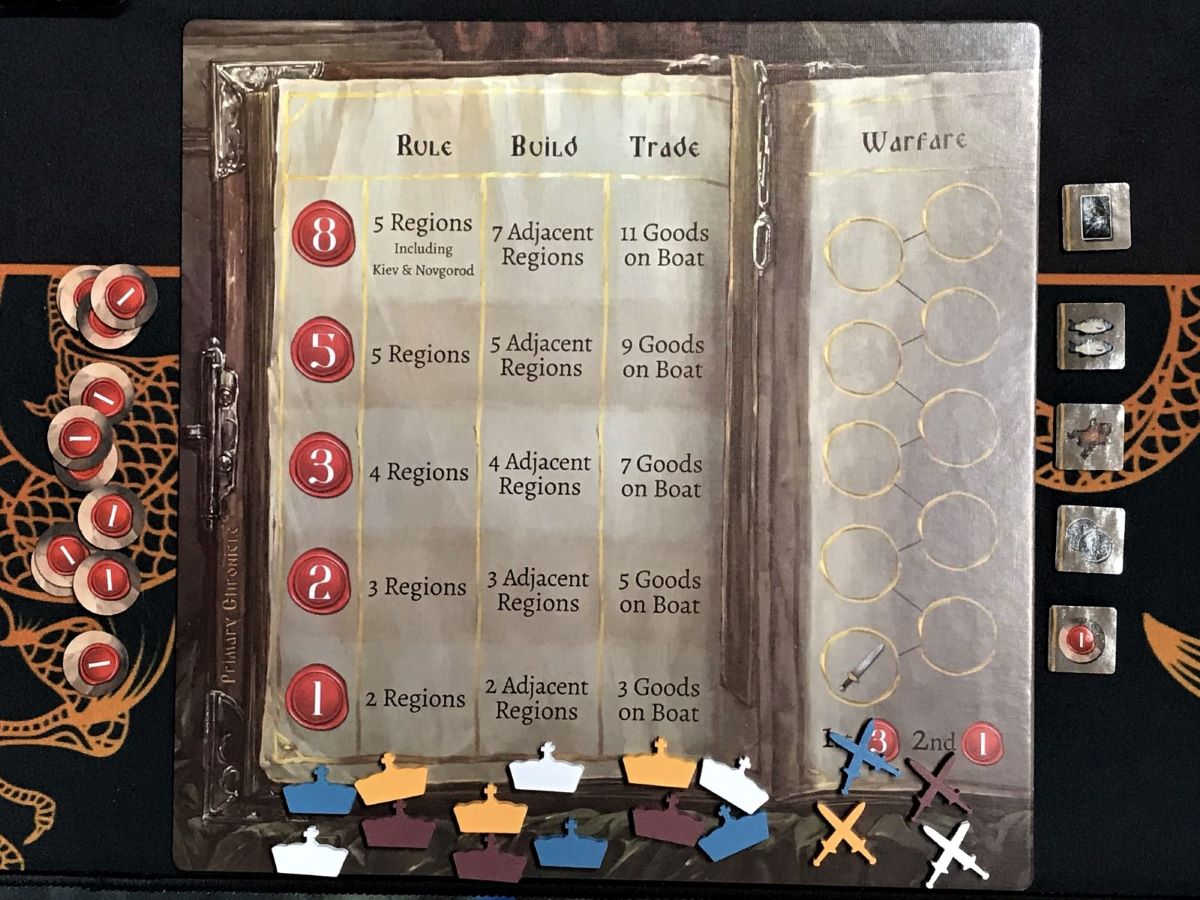
Place the Victory Point tokens off to the side. These can be earned via Agenda cards, Warfare Reward tokens, and through gameplay in the modules. Shuffle the six Warfare Reward tokens facedown, and place five of them next to every even-numbered warfare track space. Whenever a player advances their Warfare marker to one of those spaces, they earn the reward shown on the token.
At this point, you’re ready to start a game of Rurik as normal.
Epic Structures Module
Build powerful new buildings to earn rewards.
Setup is identical to that of the core content, with the following changes:
- Shuffle the “Renowned” Agenda card in with the rest of the Agenda cards.
- Shuffle the Epic Structure cards and place a number of them, and their matching structures, equal to the number of players plus one.

During a game, you may spend build points as usual to build one of the available epic structures in a region you occupy, then gain the reward listed on the card. The epic structures do not belong to any player. Some have ongoing effects, and some provide rewards at the end of a round or the end of a game.
For example, if you wanted to build the cathedral, you would replace a church you had built in a region with the new structure. You would immediately gain one Victory Point token, and whoever ruled the region with the cathedral would gain one Victory Point token at the end of the game.
The “Renowned” Agenda card awards two victory points for controlling the most regions with epic structures.
Warfare Module
This module provides more incentives and opportunities for attacking other players, allowing you to capture and ransom troops.
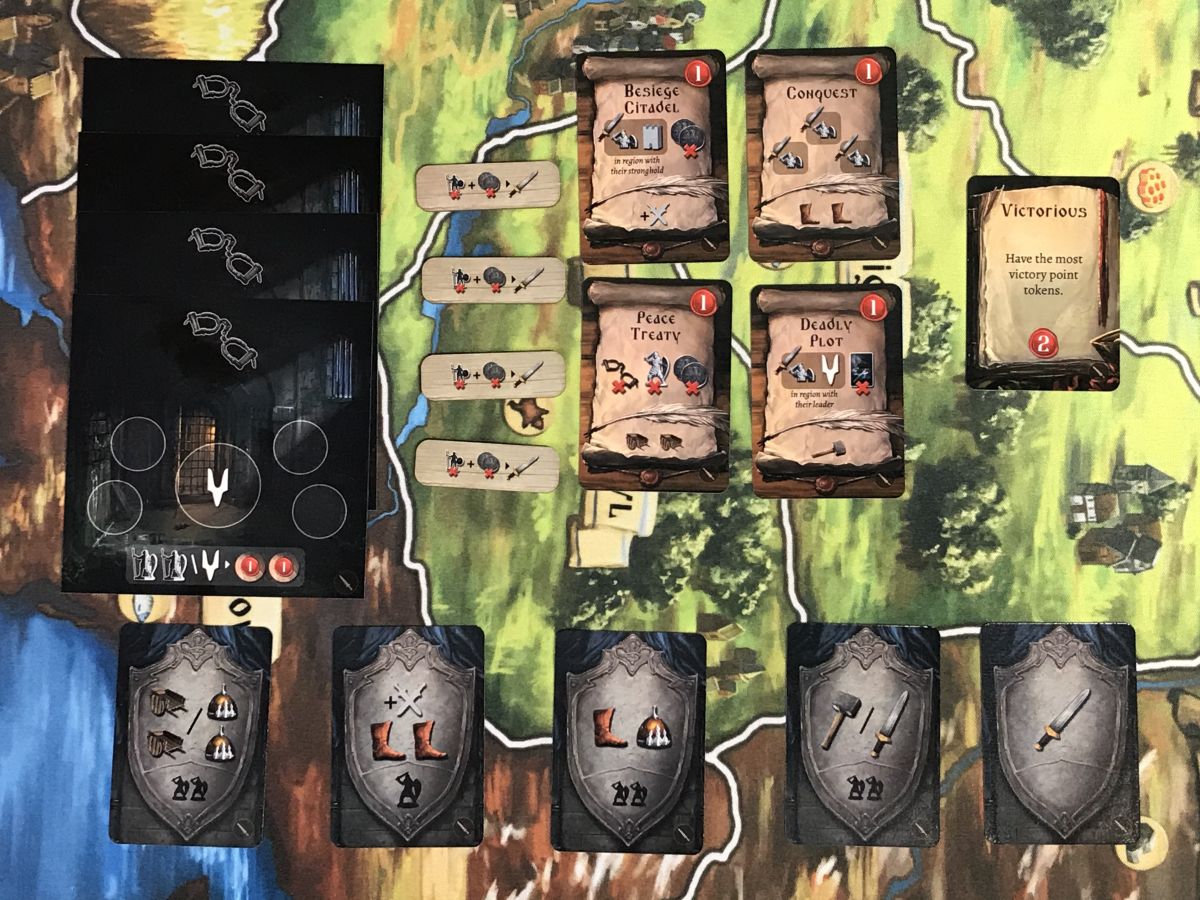
Setup is identical to that of the core content, with the following changes:
- Shuffle the Agenda, Deed, and Scheme cards marked with the warfare module symbol (a sword) into the respective core decks.
- Each player receives a Dungeon mat and a warfare Conversion token. They place the token with the two other Conversion tokens.

The warfare conversion token allows a player to return a defeated rebel to the supply and spend two coins in order to gain an attack point.
Capturing Troops
Immediately after resolving an attack, if you have revealed at least one scheme card during the combat and not suffered any casualties, you may attempt to capture the attacked troop.
To attempt the capture, reveal one card from either scheme deck:
- If the card shows a casualty, your capture attempt fails and you remove both the attacked troop as normal and one of your own troops for each casualty icon revealed.
- If the card does not show a casualty, you have succeeded. Take the attacked troop and place it on your Dungeon mat.

At the start of the claim phase, you release captives from your Dungeon and claim rewards. You receive two Victory Point tokens for a leader, and two Victory Point tokens for every two troops (can be a combination of rebels and enemy troops). Single troops do not earn you any rewards.
Rebel Factions Module
This module provides an increased role for the npc rebels, as well as a shared goal for the players to compete over to complete.
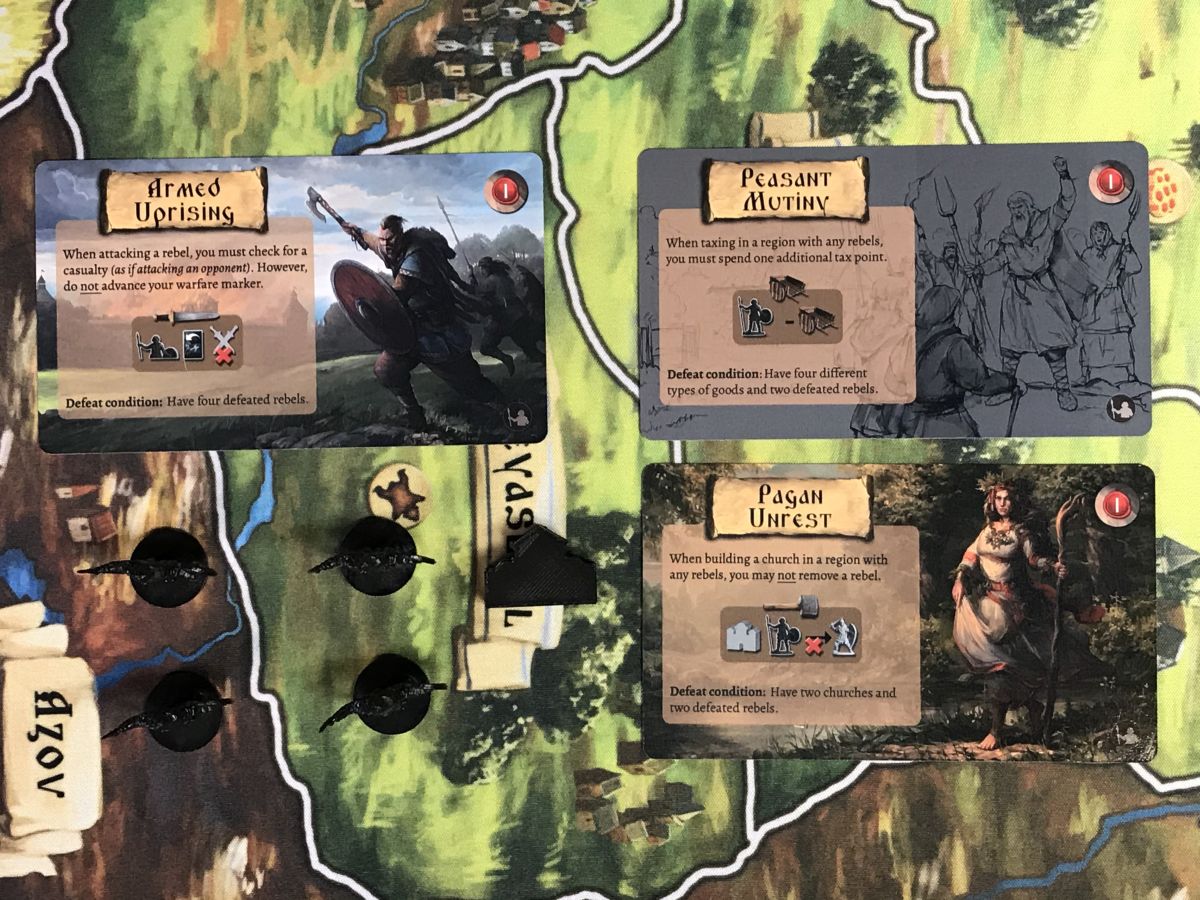
Setup is identical to that of the core content, with the following changes:
- Shuffle the Rebel Factions cards and place one face up next to the game board.
- Place the shuffled deck of Inheritance cards next to the Rebel Factions card. Reveal the top card.
- Place the Rebel Camp structure in the region indicated by that Inheritance card.
A Rebel Faction will be defeated as soon as a player meets the defeat condition listed on its card, at which point that player will earn a Victory Point token. Until they are defeated, though, play proceeds as follows:
During the Claim phase, place a random rebel miniature in one region as follows:
- If there is no rebel in the rebel camp’s region, place a rebel there.
- Otherwise, reveal the top card in the Inheritance deck and place a rebel in the region listed at the top of that card.
Additionally, there are different ongoing gameplay effects for each of the Rebel Factions until they are defeated. In the case of the “Peasant Mutiny,” if you tax in a region where there are any rebels you must spend an additional tax point.

The Verdict: Rurik: Stone & Blade
Expansions to games are always tricky propositions. Designers want to provide new experiences for players and grow the original game, but at the same time not stray too far from the formula that made it successful in the first place. Did Rurik: Stone & Blade accomplish this? Let’s take a closer look.
First up, the core components. These make changes both big and small to Rurik: Dawn of Kiev, but in ways that don’t fundamentally affect the overall way you play the game. The biggest of these changes is certainly with the introduction of the Inheritance cards. Before, players would start with different leaders and Agenda cards, but otherwise would begin play with identical resources. But with the Inheritance cards, there is more asymmetry to the setup, with players also needing to do a bit of strategizing as to which two cards to keep. None of the rewards on those cards seem to be game breaking, but rather provide small edges in pursuing different goals.
One of the few complaints about Rurik: Dawn of Kiev in my player group was the difficulty at times in gaining resources. With both the Trade Boon tokens and the Warfare Reward tokens, there are now two additional ways to receive goods. The Trade Boon tokens are especially beneficial as they can stand in for any of the different goods. It can sometimes be difficult to reach certain regions that contain goods you need; Trade Boon tokens can help reduce that issue. And the Warfare Reward tokens encourage players to engage in more combat by providing additional benefits. Many of my original games of Rurik: Dawn of Kiev saw little combat between players, as foregoing other potential actions in return for the endgame Victory Points you earned on the combat track generally weren’t worth it.
As to be expected with any expansion, there is also more variety introduced, which allows players to adopt new strategies. There are two new leaders introduced, each with their own new powers. Additionally, two new basic structures give you more flexibility in what you can build.
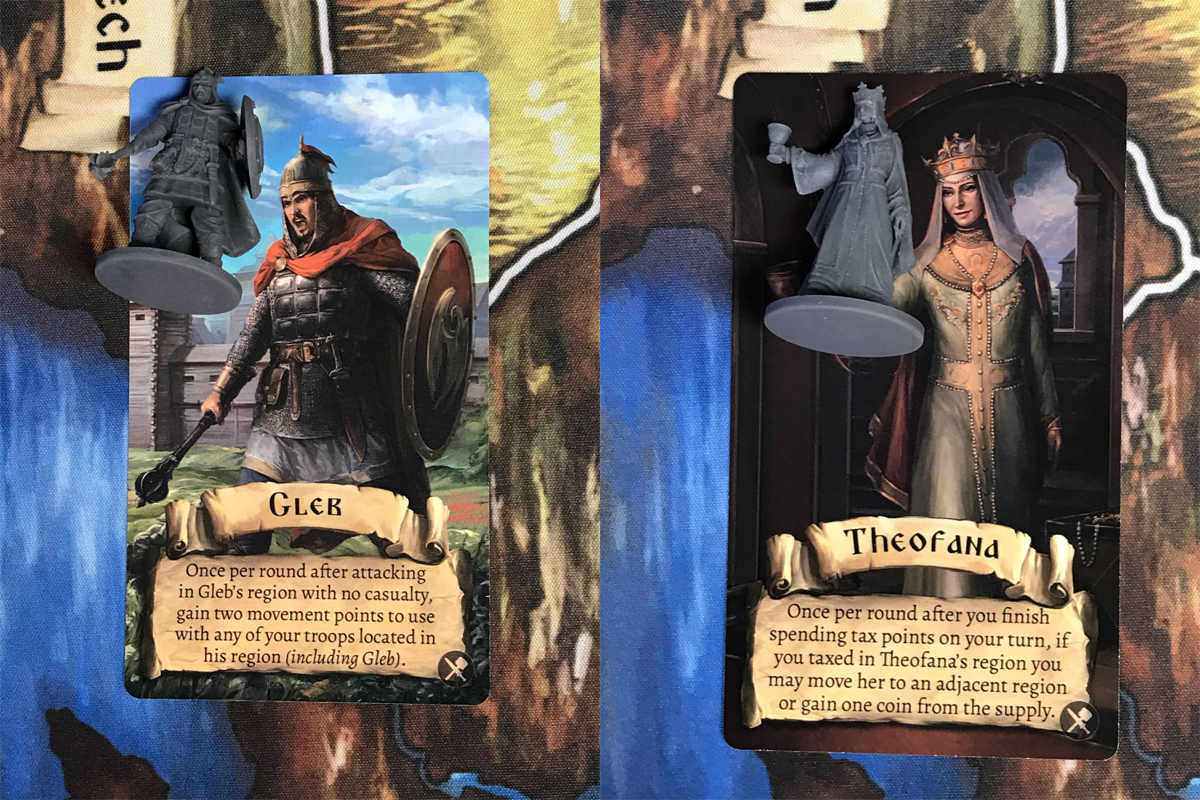
The core content brings great quality of life changes to the base game of Rurik: Dawn of Kiev. If you’re happy overall with how the original game plays, the gameplay tweaks provided by the core content should make you happy. But with the addition of the three gameplay modules, PieceKeeper Games has given players fresh ways to play Rurik without fundamentally breaking the original game. You can play with just one module at a time, or combine two or even all three together for a very different gameplay experience. This is most apparent with the Warfare module, which provides a very real path to victory by actively engaging in combat. Successfully capturing rebel and enemy troops can yield a lot of victory points. But there’s a definite risk/reward at play with the capturing mechanism, as your troops are doubly at risk by drawing an additional scheme card after the attack.
Of course, all of this content comes at a cost (and I don’t mean financially). There are new rules to learn, and the additional rules and complexity will add to your gametime. With the original game, the estimate of 30 minutes/player was right on the nose. PieceKeeper is estimating 35 minutes/player with the expansion, but I’d say that only holds true with the core content. Each module you add in will incrementally increase the length of your game. However, while you are integrating new rules, none of them are difficult to understand. Once players learn them, they should become second nature.
The Rurik: Stone & Blade Kickstarter campaign will be offering stretch goals that provide new goodies to add variety to your game. There will also be several add-ons available to purchase, notably a reprint of the oversized neoprene mat from the first Kickstarter, which you can see on my Origins game table:
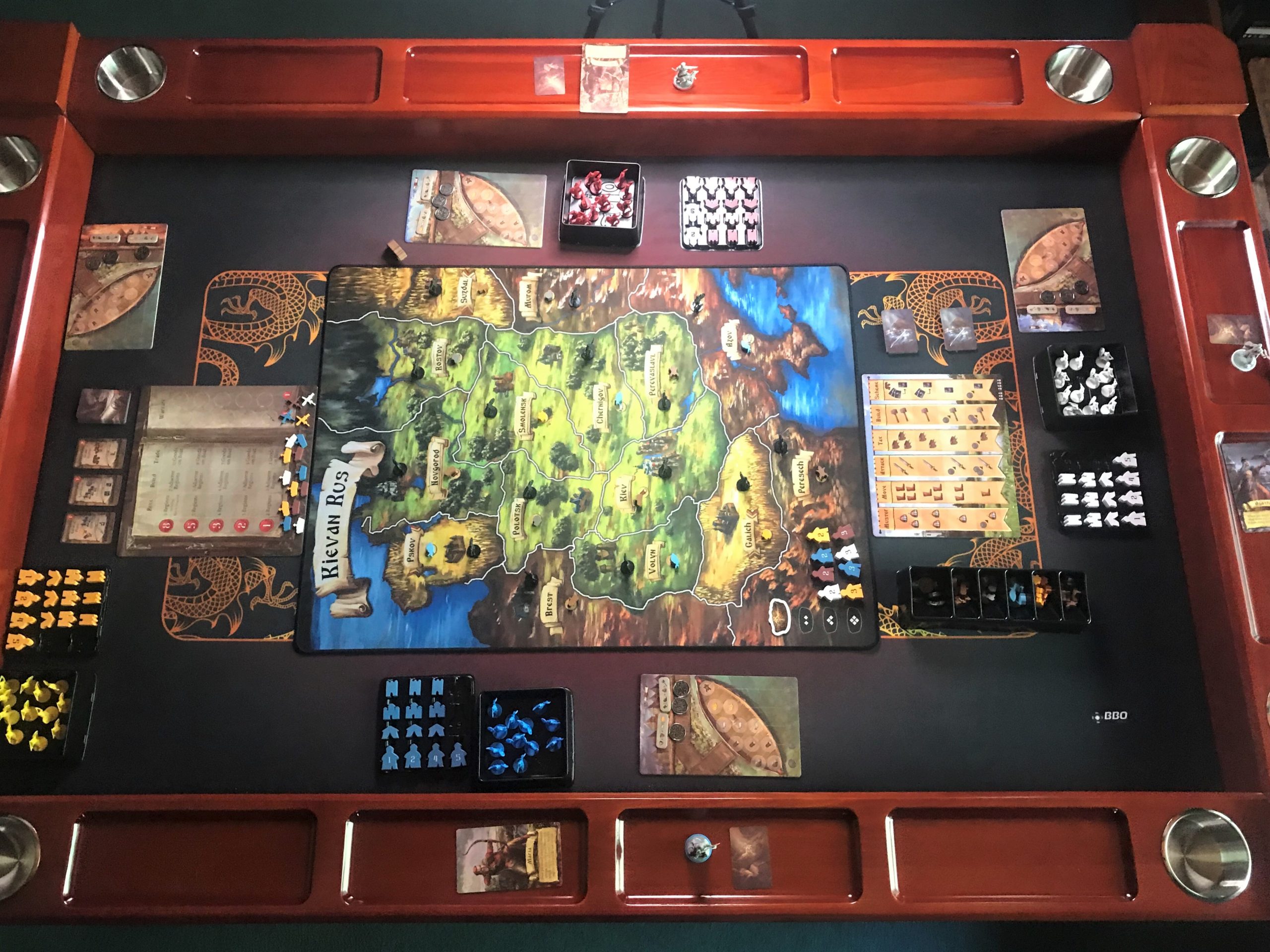
If you’ve never played Rurik: Dawn of Kiev but you think you’d enjoy the game based on my review, I’d suggest picking up the original game along with the expansion during the Kickstarter. And if you do currently own a copy, and it’s been seeing regular table time, then Rurik: Stone & Blade is, in my opinion, an auto-back. Besides bringing some great tweaks to the already enjoyable gameplay, it provides enough content to keep your games fresh and strategically challenging for a long time to come.
For more information or to make a pledge, head on over to the Rurik: Stone & Blade Kickstarter campaign page.
![]() To subscribe to GeekDad’s tabletop gaming coverage, please copy this link and add it to your RSS reader.
To subscribe to GeekDad’s tabletop gaming coverage, please copy this link and add it to your RSS reader.
Click here to see all our tabletop game reviews.
Disclosure: GeekDad received a copy of this game for review purposes.





